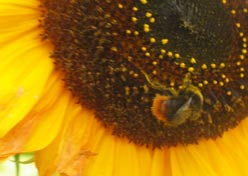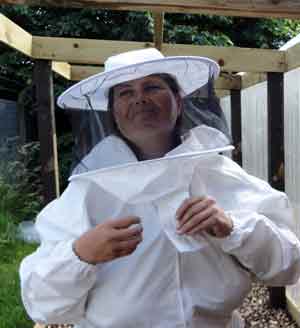Missing Bees: A Worldwide Problem That Concerns Us All

Where are the missing bees?
Bees are dying at an unprecedented rate. It's a new and serious problem with implications for all our futures.
What is happening to the bees? Why are bees dying? And what can we do about our disappearing and missing bees?
This page takes a look at the problem and some of the theories which try to account for what is going on. There's also a few suggestions for action you can take to support bees.
Disappearing bees
- according to Albert Einstein and Rudolf Steiner
"If the bee disappeared off the surface of the globe, then man would only have four years of life left. No more bees, no more pollination, no more plants, no more animals, no more man."
- Quote attributed to Einstein
That is a stark, no-punches-pulled way of putting it!
Actually there is some doubt as to whether Einstein really said that - the quote only surfaced on the internet in 2002!
But a slightly less-famous contemporary, Rudolf Steiner, warned in 1923 that if humans continued cultivating honeybees, they would be dying out within 80 years. (Steiner was the founder of the biodynamic movement, a system of agriculture based on organic, sustainable principles.)
Read more about the artificial ways in which many bee colonies are treated below.
Missing bees: a worldwide problem
Facts and theories about disappearing bees
Here are some of the facts and theories to account for the decline in bee populations. But first, just how bad is the problem of dying bees? And when did the missing bees first start to go missing?
Honeybees are down around 60% in the UK since the 1970s. In some parts of the world the decline is as much as 80%. In the USA honeybee populations have been declining for the last twenty years and beekeepers are finding it hard to produce enough honey for public demand.
Bumblebees are also under threat; three species have entirely disappeared from the British Isles in recent years. Others are in decline.
The problem is clearly not just a problem for the bees; it affects the entire planet in that many, many plant species rely upon bees for pollination.
Pollinating partners
Many human food crops are among the plant species affected. In fact, more than 90 common crops that we rely on are pollinated mainly by bees. They include such staple foods as apples, asparagus, avocados, broccoli, citrus fruits, celery, cucumbers, nuts, soybeans, strawberries and tomatoes, just to name a few.
If bees were to die out completely many animal species would die out too.
If bees really were to suffer a catastrophic population collapse, worldwide food shortages would quickly follow.
So what is causing the deaths of so many bees? Why are entire colonies failing to thrive? And, most important - what can we do about the missing bees problem?
Here are some of the theories which have been put forward to explain the phenomenon of the missing bees.
Missing bees: a worldwide problem
Colony Collapse Disorder (CCD) and mobile phone masts
Many bees are suffering from Colony Collapse Disorder (CCD). The hive becomes rapidly defunct with only the queen, eggs and a few immature bees left in the hive. The worker bees are thought to die away from home when they are unable to return. Without them the colony quickly dies too.
One possible answer is that mobile phone masts may be disorienting bees by interfering with their navigation systems. In which case, they are quite literally becoming missing bees - they are just getting lost! Mobile phone masts have gone up all over the planet. They emit radiation which has been linked to health problems for some people. Unfortunately, once lost, bees are likely to stay lost and die away from the hive.
The problem of colony collapse may well be caused by a number of problems acting at the same time; pollution and pesticides, declining food species, erratic weather patterns to name just a few.
Missing bees: a worldwide problem
Pesticides as a possible cause of bee deaths
The German pesticide company Bayer has many of its products labelled as "bee-friendly". This has been accepted by the British Beekeepers Association.
Even so, the nicotinamide pesticide clothianidin has been blamed for the deaths of millions of bees in the Rhine valley. The company continues to assert that the pesticides were incorrectly used.
Neonicotinamides or "neonics" (of which clothianidin is just one example) are the new weapon of choice by many large crop farmers and by some domestic gardeners, too. They affect the whole system of the plant and are highly toxic to bees and other insects feeding on the pollen and nectar.
These pesticides are now widely used and have been in use for about 20 years. Corn farmers in the US have been using them widely, as have many cotton and soybean farmers. Studies have shown that extreme declines in bee numbers are associated with their use. See Mother Jones for more details of these studies.
Some countries are now outlawing the use of these pesticides - Italy, France, Slovenia and Germany, for example. They are legal in the UK.
Neonics have several effeects upon bees. They disrupt the development of larvae and they affect the homing ability of adults, both qualities which cause problems for bee colonies. Even low doses of these insecticides are thought to affect the immune system of bees, making them more susceptible to diseases such as varroa.
The varroa mite
Another problem for bees has been the parasitic varroa mite. Aptly named Varroa destructor, this mite attacks bees by feeding on both adult bees and their young, depleting the strength of the colony.
The mite will eventually destroy a colony unless control measures are applied. The weakened bees are left susceptible to other pathogens, such as viruses. Some individual bees may survive varroa mite infestation but they may suffer deformities and a shortened life-span as well as being more susceptible to other diseases.
If varroa mites are not properly managed in a colony, the end result will almost certainly be colony collapse (CCD). Normal bee activities such as food foraging, defending the colony and feeding the young become neglected. This can happen quite quickly in a seemingly-healthy colony. Mite infestation between colonies can happen quite quickly, too, especially when bees are more active in the spring and summer months.
Originally an Asian problem, this mite has been active in the UK since 1992 and is becoming increasingly resistant to the usual pyrethrum-based treatments. It has posed a huge economic problem for bee-keepers worldwide. The only place to escape the mite so far has been Australia.
For more details of this and other problems facing the bees see Fruitless Fall: The Collapse of the Honey Bee and the Coming Agricultural Crisis available from Amazon.
Missing bees: a worldwide problem
Good hygiene and hive management
There are now detailed hive management techniques which allow commercial bee keepers and small hobby beekeepers to maintain some control over this mite. Pyrethrum treatments such as Apistan andBayvarol are used and a new treatment Apiguard is also used when resistance to pyrethrum-based products becomes evident.
Integrated Pest Management (IPM) techniques are also increasingly used as they are more eco-friendly. They consist of good hygiene and other management techniques as well as some use of chemicals (authorised varroacides) such as the insecticides already mentioned. Some of the physical methods of control (biotechnical methods such as 'comb trapping') are time-consuming and not usually sufficient to cure the problem if used alone.
Research into biological controls is on-going in the USA and the UK. There are also breeding programmes in many countries to develop more tolerant strains of bee which are not overwhelmed by the varroa mite.
One reason for the resistance of varroa to the various chemical controls is thought to be the unauthorised use of chemicals. Some untested chemicals may be unsuitable for varroa control and even the authorised ones may, if used incorrectly, cause contamination of the honey produced.
It's not an open and shut case that varroa is the main cause of colonies dying. The rise of varroa begs the question why are bees now so susceptible to this mite? One US study could find no direct correlation between bee health and varroa infestation.
Hive beetles
A similar problem with insect infestation is found in bee colonies in tropical regions.
The hive beetle is about 1/3rd the size of its host. These beetles smell the honey from a hive and lay their eggs which hatch into maggots. The maggots feed on bee eggs and can completely destroy the colony. Even light infestations are a problem because the quality of the honey is badly affected, making it unsaleable.
It may be a cause of missing bees in other regions, too.
There is some evidence that this tropical pest is becoming more widespread with climate change. It has colonised several states in the US, including Florida. It is a particular problem for European bee varieties which do not have as good defences against it as their African cousins.
Sponsored links
Genetically modified (GM) foods
One other cause of the decline of bee populations might be genetically modified crops (GM).
Many of these are designed to be more resistant to pesticides and so pesticide use can tend to rise for such crops. It has been understood for many years that pesticides can pose a significant threat to insect populations, killing the good guys as well as the bad.
Missing bees - another disease route
Another route for infection of wild bees with parasites and viruses may be the use of specially bred bees for use in greenhouses and polytunnels. The bees are used as pollinators for crops. When the specially bred honeybees use the same food plants as wild bees, cross infection occurs. Bumblebees have been infected with viruses by this method according to a UN study.
Missing bees: a worldwide problem
Where have all the flowers gone?
Another factor that might be important is that there are fewer wildflowers for bees to choose as food plants.
A report on Britain, Germany and the Netherlands in 2006 showed that not only were there fewer types of bees and numbers of bees in some areas but the numbers of wildflowers had declined too. This could mean that the wildflowers are not reproducing properly because of the lack of sufficient bees to pollinate them. This could be a vicious cycle which would need a rethink in our wildlife policies to rectify.
Global warming and climate change might also play a part. Crop plants have been flowering unseasonably early in some areas. This can mean that there are no bees around to pollinate them. Later in the spring when the bees emerge, the flowers have already finished so no fruits form. Poor crops of peas and beans have been noted in some areas after earlier than usual flowering of the plants.
Global warming also leads to erratic and extreme weather patterns which can make it more difficult for both bees and wildflowers to thrive. Flash floods and unseasonal frosts, droughts and storms can all take their toll.
A whole lot of reasons...
Even if only a few of the above causes of bee deaths are actually happening, we can see that the environment for bees and other beneficial insects is being compromised. Bees are under threat from a variety of sources and for some colonies these problems are leading to a very real battle for survival.
Clearly, some of these environmental threats need to be removed or lessened if we are to ensure the future of bees - and all the species which depend upon them, ourselves included.
Missing bees: a worldwide problem
What can we do to help bees?
Farmers are being encouraged to plant wildflower strips along field verges. They can also join environmental stewardship schemes.
Organic farming methods are generally a lot more bee-friendly. Integrated Pest Management schemes reduce the amounts of pesticides used on farms and Permaculture methods generally eliminate the need for pesticides altogether by creating a sustainable and harmonious plant community in growing areas.
Picture: A community beekeeper at work
Gardeners can plant plenty of nectar-giving flowers such as rosemary and foxgloves. The bees in my garden absolutely love the lavender and marjoram. Rosemary is also a favourite.
Keep off the spray bottle and use far more cottage garden plants. In general, the open pollinators are best - plants such as marigold and limnanthes (poached egg plant) which bees and hoverflies can access easily. Double headed flowers look showy but are generally much less accessible and may not produce much nectar.
Plant a wildflower garden, if you have the space.
Are you interested in learning how to keep bees at home successfully? Click here for a complete home study course with video examples to follow.
There are also community bee projects which are well worth supporting.
Ashville has become the first "Bee city USA" and is hoping to promote the idea around the US.
The Xerces Society has a Bumblebee Project needs help from citizen scientists and is encouraging people to create habitat.
There is also the Backyard Bee Count which is running a project to plant sunflowers and other food plants for bees.
In the UK there are many small community bee projects.
The one shown below is a local project in Suffolk where school children and members of a community garden collaborate to run three hives. The mesh screens provide a protected viewing area for members of the public and other observers.
Here are some books about bees, beekeeping and the current problem of dying bees.
Books about bees
Langstroth's Hive and the Honey-Bee: The Classic Beekeeper's Manual One of the original and best guides to beekeeping. Although it was written 150 years ago it still contains invaluable insights because Langstroth was such a good naturalist and observer.
Natural Beekeeping: Organic Approaches to Modern Apiculture Contains loads of ideas for keeping a healthy hive without any resorting to chemicals.
Fruitless Fall: The Collapse of the Honey Bee and the Coming Agricultural Crisis If you want more detail about the crisis facing honeybees and our planet - this is the one to read.
Robbing the Bees: A Biography of Honey--The Sweet Liquid Gold that Seduced the World A wonderful book from someone who loves her bees! Lots of background info - for example about the introduction of Africanized bees from Brazil, and other historical insights.
*****
Greenfootsteps Home - for more easy green living ideas
Missing Bees - a Worldwide Problem - copyright 2010
| Tweet |

| Tweet |

On other pages:
Sponsored links
Footprints
- an occasional e-zine from Greenfootsteps
If you would like to receive the e-zine, please just sign up below.
- a heartwarming story about a family and a honey farm








New! Comments
Have your say about what you just read! Leave me a comment in the box below.